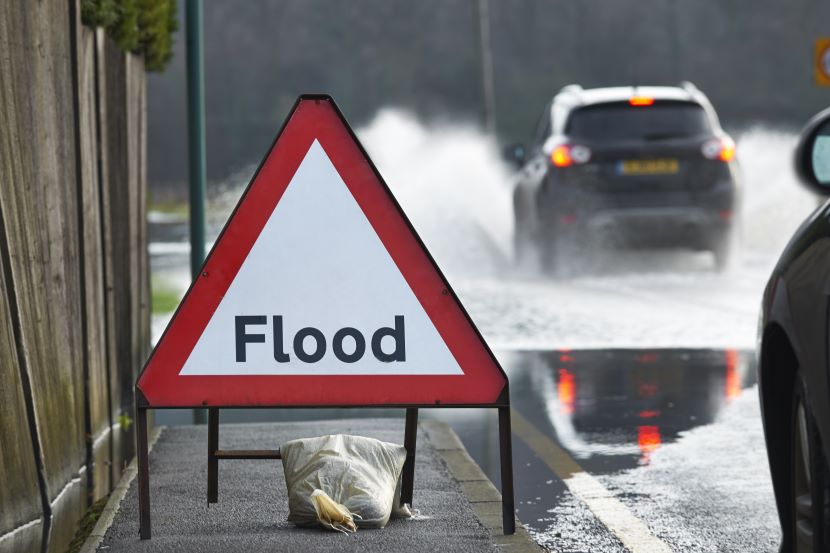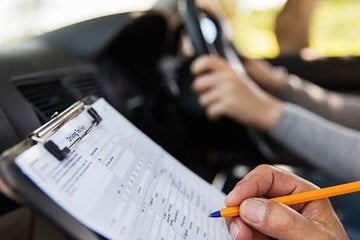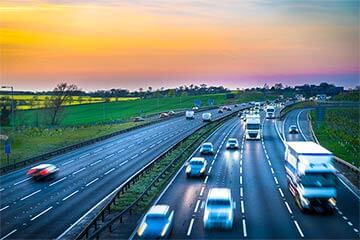Heavy rainfall and flash floods can be dangerous and can cause serious damage to your car. Many vehicles are even written off by insurers due to water damage.
This is why it’s important to have the right car insurance cover in place and to know what to do if your car is a victim of flooding.

Does my car insurance cover flood damage?
If you have a fully comprehensive car insurance policy and your vehicle is damaged by flooding, you should be covered.
If you’re unsure, it’s wise to check your policy documents.
If you have a third-party or third-party, fire and theft policy, this basic cover is unlikely to protect your car against flood damage.
Even if you’re covered for some flood damage incidents, insurers want to know whether the damage was avoidable or unavoidable, as this could impact your claim.
If you live in an area prone to flooding, it’s probably worth considering a comprehensive car insurance policy.
But if you’re unsure whether or not you live in an area of high risk of flooding, these are some flood-risk areas in England.
What is avoidable vs unavoidable flood damage to your car?
Most insurers expect you to take precautions to safeguard your car, especially during bad weather. So when deciding whether or not to pay out for flood damage, an insurer puts your claim into 1 of these 2 categories:
- Avoidable flood damage: This is damage that you should have anticipated and taken steps to avoid happening.
- Unavoidable flood damage: This is damage you wouldn’t have been able to predict or get away from.
Most flood damage is no fault of the owner and is therefore classed as unavoidable flood damage. This might include, for example, parking your car at home to find it flooded in a sudden storm or by torrential rain.
But, if you left your car at the bottom of a harbour slipway and it submerged, your insurer is likely to classify it as avoidable damage. This means you’re unlikely to get a car insurance payout.
Similarly, driving through a flooded street and finding the water is deeper than you anticipated is likely to be considered as avoidable flood damage.
Can I drive during a red weather warning
Yes, your car insurance should cover flood damage during a red weather warning.
Just because there’s a red weather warning doesn’t mean your insurance is invalidated should you choose to drive in it.
But if you ignore speed restrictions or drive dangerously and crash, this might influence the decision by the insurer to cover your claim.
So while bad weather itself doesn't normally invalidate your insurance, driving recklessly could. This is why it's always best to drive safely in heavy rain and wind.
What should I do if my car is damaged by a flood?
If you get stuck in floodwater, it's usually best to wait in the car and call for help.
Urban flood water can carry dangerous bacteria from drains and sewers, causing disease. And rural floodwater is more likely to be contaminated by agricultural chemicals and animal waste.
If your car is damaged by a flood, you should:
-
Avoid opening the bonnet. This helps prevent your car’s delicate electrical systems from getting soaked.
-
Avoid restarting your car. If your engine cuts out after driving through deep water, restarting it might damage your engine further.
-
Turn on the hazard lights. Call your breakdown cover provider and have the vehicle professionally examined after they arrive.
-
Contact your insurer. Once you've been safely recovered by breakdown services, your next step is to call your insurer. Inform them if the damage is confined to the engine or if it includes the car’s interior as well. You could take photos, too, to be extra thorough.
-
Avoid drying the car yourself. Don't be tempted to dry the car out yourself before it’s assessed by your insurer, as this requires professional expertise.
What can water damage do to my car in a flood?
Flooding can cause severe damage to your car.
Even minor flood damage can:
- Cause rust and mould
- Damage the brakes
- Damage the fuel tank
- Rot door seals
- Contaminate oil, petrol and other automotive fluids
- Prevent indicators and sensors from working properly
What water damage does my car insurance policy cover?
If your insurer covers you for floods, this usually includes damage to upholstery and entertainment systems. It might also include any necessary repairs to the mechanics and electrics of the vehicle.
But this depends on the terms of your policy.
If your personal possessions have been damaged, your car policy might also include contents cover.
If it doesn’t, it’s possible you may already have ‘contents outside the home cover’ as part of your contents insurance policy. So it’s worth checking.
Another aspect to consider is if any finance owed on the car is more than what an insurer would pay out. Gap insurance should be able to help with this.
Gap insurance is a standalone policy that ensures you don't end up losing money. It’s designed to bridge the gap between the amount you paid for your car and the amount your insurer pays out if you claim.
Does my car insurance cover water damage to the engine?
Repairing the engine is perhaps the most expensive damage to address. In some cases, it can lead to a car being written off.
The good news is that if you have fully comprehensive insurance cover, your insurer should pay the bill.
But remember the information about avoidable vs unavoidable water damage. If the damage was something you could've avoided, you might find your policy doesn't pay out.
How do I make a claim for flood damage?
First, contact your insurer as soon as possible.
They should arrange for an approved mechanic to visit and assess the damage.
Your insurer then decides whether they'll repair the car or write it off.
There are several things you need before you make the call to claim on your car insurance:
-
Your car registration
-
Policy number
-
Photos of the flood damage
-
The location of the incident
Is my car a write-off after flood damage?
Insurers classify a car that’s too expensive to repair as a write-off and pay an agreed amount to the vehicle's owner.
The insurance company then keeps the car to dispose of as it sees fit.
Write-offs are assessed by the insurance industry and classified into 4 categories, depending on the severity of the damage.
Flood-damaged cars are generally graded as Cat N (short for non-structural damage), which replaced the old Cat D classification in 2017.
Even though the insurance company has judged it as too expensive to repair, Cat N cars can legally be put back on the road.
Insurance companies typically base their repair estimates for spare parts on manufacturer price lists. These tend to be expensive.
It’s common for garage owners to buy flood write-offs from insurance companies, repair them with generic spares and get them back on the road.
Automotive data specialist CAP HPI has warned about the dangers of buying flood and water damaged-vehicles, despite their lower prices.
HPI says if a flood-damaged car hasn't been repaired properly, it's likely to need entire engine components replaced to ensure the car works safely.
How do I keep my car safe during a flood?
If the conditions are worsening as you’re driving, pull over and check for flood alerts and flood warnings.
Try to head to higher ground if you think you’re going to be affected rather than continuing on your original route.
Don’t just assume that the driver in front knows what’s happening, either. Even if they have local knowledge, it’s dangerous to follow anyone else into floodwater.
You won’t know what you’re driving into and it doesn’t take much water for you to be swept away.
How to safely drive through a flood
If you’re unsure how deep the water is or if there’s fast-flowing water, stop and find an alternative route.
Water that’s higher than your front bumper can be too dangerous to drive through. About 30 cm of flowing water is enough to potentially wash away a car.
If you’re able to measure the water’s depth, do so.
Once you’ve assessed the situation and feel it’s safe to continue, let approaching vehicles drive through first. You can then follow these steps to safely drive through the flood:
Drive in the middle of the road if safe to do so
You need to drive alongside the highest point of the road to avoid the worst of the floodwater - this is often in the middle.
This should also help you avoid further damage by avoiding the kerb and any soft verges.
Keep to a low-speed
You could rip your bumper, flood your engine or cause other damage if you drive too quickly. Your tyres could also lose contact with the road potentially meaning you lose control of the car.
Depending on the situation, it’s recommended you drive around 3-4 mph to safely get through the floodwater.
But try to stick to first gear to keep the revs high. This should help keep the water out of the exhaust.
If you’re driving an automatic car, use the lowest gear possible and keep your foot on the accelerator.
Use your headlights
Use the car’s headlights to help other drivers see you more clearly. It should also help with your own field of vision.
But try to avoid using your fog lights as this could affect other drivers if they’re too bright.
Don’t stop
Once you’ve found a comfortable speed and know you’re safe to continue, don’t stop moving until you’re out of the water.
Stopping in floodwater could flood your exhaust pipe or even your engine. It also increases the likelihood of damaging your car.
Stay inside the car
If your car breaks down, pull over, put the hazard lights on and stay inside the vehicle.
Floodwater could contain bacteria and the conditions can make it more difficult for other drivers to see you.
Don’t check the car’s condition yourself - wait for your breakdown cover provider to arrive first. Exposing your engine to excessive rain or water can damage it.
Test your brakes
Once you’re out of the floodwater, stop and check your brakes. Gently press them when it’s safe to do so to clear any water.
Make sure they work properly before you restart your journey.
Compare car insurance quotes
* Confused.com data. October 2023 - October 2024. Comprehensive policies only







